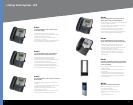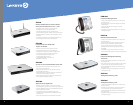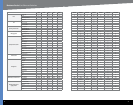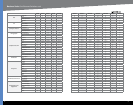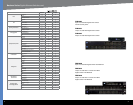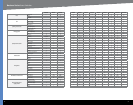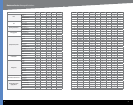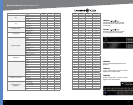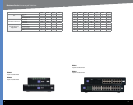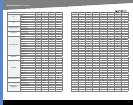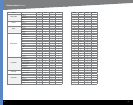
IEEE (The Institute of Electrical and Electronics Engineers) An international non-profit, professional organization directed
toward
the advancement of the theory and practice of electrical, electronics, communications and computer engineering.
Infrastructure Currently installed computing and networking equipment.
Infrastructure Mode Configuration in which a wireless network is bridged to a wired network via an access point.
Intrusion Attack A type of internet attack in which an attacker tries to gain or access the information transimitted through
the networks.
Intrusion Prevention System A mechanism to detect malicious software , such as Internet worms, Trojan Horses, and DDoS,
that can’t be detected by a conventional firewall.
IP (Internet Protocol) A basic protocol used to send data over a network. Allows the sender to transfer data, but does not
establish a direct link with the recipient.
IP Address The address used to identify a computer or device on a network.
IPSec (Internet Protocol Security) A VPN protocol used to implement secure exchange of packets at the IP layer. Most widely
used for enabling virtual private networks.
ISP (Internet Service Provider) A company that provides access to the Internet.
ITSP (Internet Telephony Service Provider) A company that provides voice communication service over the Internet (VOIP).
JBOD (Just a Bunch of Drives/Disks) Multiple hard disk drives (HDDs) that have been combined into a single virtual drive. In a
JBOD configured disk array, each drive may be of a different size or capacity, thus, this storage method can be used to turn two
or more odd-sized hard drives into one useful drive.
LAN (Local Area Network) The computers and networking products that make up the network in your home or office.
Layer 2 In an Open Systems Architecture (OSI), the Data Link layer; this layer is responsible for moving data across the physical
links in a network, for example with a switch.
Layer 3 The Network layer of an OSI device; determines network addresses, routes, and quality of service for information
transport. A router is a Layer 3 device, but switches can also have Layer 3 capability.
LEAP (Lightweight Extensible Authentication Protocol) A mutual authentication method that uses a username and
password system.
MAC (Media Access Control) Address The unique address that a manufacturer assigns to each networking device.
Managed Switch A network switch with an IP address that lets you monitor and administer your network.
Mbps (Megabits Per Second) One million bits per second; a unit of measurement for data transmission.
MIMO (Multiple-in, Multiple-out) A technology that uses multiple radio antennas that can each send and receive more than
one wireless signal. 802.11n uses MIMO to increase bandwidth and range.
Multicasting Sending data to a group of destinations at once.
NAS (Network Attached Storage) A data storage device on a computer network to provide a centralized repository of data
that can be shared and accessed by other end-users or workgroups on the network. The Linksys Business Series NSS products
are NAS devices.
NAT (Network Address Translation) NAT technology translates IP addresses of the local area network to a different IP address for
the Internet.
NAT (Network Address Translation) Traversal A method of enabling specialized applications, such as Internet phone calls, video,
and audio, to travel between your local network and the Internet. STUN is a specific type of NAT traversal.
Network A series of computers or devices connected for the purpose of data sharing, storage, and/or transmission between users.
Node A network junction or connection point, typically a computer or work station.
OFDM (Orthogonal Frequency Division Multiplexing) Frequency transmission that separates the data stream into a number of
lower-speed data streams, which are then transmitted in parallel to prevent information from being lost in transit.
Packet A unit of data transmitted over a network.
Passphrase Used much like a password, a passphrase simplifies the WEP encryption process by automatically generating the WEP
encryption keys for Linksys products.
Parity A method of attaching additional binary digits to data blocks that enables a NAS controller to monitor whether data has
been lost or written over after it has been moved from one place to another in a storage array or among networked computers.
PBX (Private Branch Exchange) A private telephone network used within a business. Users share a certain number of outside lines
to make external phone calls.
PEAP (Protected Extensible Authentication Protocol) A protocol for transmitting authentication data, including passwords, over
802.11 wireless networks.
Ping (Packet Internet Groper) An Internet utility used to determine whether a particular IP address is online.
PoE (Power over Ethernet) A technology enabling an Ethernet network cable to deliver both data and power.
Port The connection point on a computer or networking device used for plugging in a cable or an adapter.
PPPoE (Point-to-Point Protocol over Ethernet) A type of broadband connection that provides authentication (username and
password) in addition to data transport.
PPTP (Point-to-Point Tunneling Protocol) A VPN protocol that allows the Point to Point Protocol (PPP) to be tunneled through an
IP network. This protocol is also used as a type of broadband connection in Europe.
Preamble Part of the wireless signal that synchronizes network traffic.
PTSN Public Telephone Switched Network. Standard public phone lines outside a PBX.
QoS (Quality of Service) A mechanism which gives priorities to certain types of traffic to ensure the throughput; for example,
streaming multimedia.
Rack A standardized metal frame used to hold various computer hardware devices that can be stacked on top of one another. Also
known as a computer cabinet.
RADIUS (Remote Authentication Dial-In User Service) A protocol that uses an authentication server to control network access.
RAID (Redundant Array of Inexpensive or Independent Disks) A set of data storage schemes for combining and configuring
multiple hard disk drives to store business-critical data in such a way as to provide long-term accessibility of the data and/or quick
access and archiving of the data. Different RAID levels have different attributes and performance/functional tradeoffs. Some offer
better methods for data integrity, fault tolerance, throughput or capacity. Based on the specific needs of the users connected to
the storage device some RAID levels may be more suitable than others. Current RAID level schemes include: RAID 0 – Striping; RAID
1 – Mirroring; RAID 4 – Independent Access with Dedicated Parity (not often used); RAID 5 – Independent Access with Distributed
Parity (very popular method). Currently, the NSS device offers the choice of five different RAID levels (including JBOD) with two op-
tions for adding a hot spare to an existing RAID level.
RJ-45 (Registered Jack-45) An Ethernet connector that holds up to eight wires.
72 73



